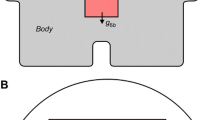Conclusions
1. We have developed a graphical method for determination of the temperature of the different parts of the brain during craniocerebral cooling by means of the “Kholod-2F” apparatus; the method requires no direct placement of thermocouples in the brain, and indications are obtained from temperature measurements within the ear or body of the patient.
2. We have drawn up nomograms for use with craniocerebral cooling; they enable the temperature of any part of the brain to be determined, as well as the time required to cool that part to a given level. They also enable temperature distribution in the head to be determined without measurement if the patient's weight and time of cooling are known.
3. We have determined the relationship (Fig. 3) of esophageal to rectal temperatures during craniocerebral cooling.
4. Results show that use of craniocerebral hypothermia induced by “Kholod-2F” enables rapid cooling of the human cerebral cortex to be obtained (1–1.5° per min at the start of cooling) by application of a heat conductor at a temperature of 0.5–2°; body temperature remained within safe limits.
The temperature of the external auditory meatus measured at the ear drum does not indicate the temperature of the medulla but corresponds to the brain temperature at a depth of about 25 mm (34 mm from surface of head).
The temperatures of the deep layers of the brain depend chiefly on body temperature, and are 1–1.5° lower than it. Further body cooling does not alter temperature distribution within the head, but only reduces the cooling time.
5. A relationship has been obtained (Fig. 2) which enables the experimenter using “Kholod-2F” in experiments to follow temperature changes in the relevant parts of the brain and esophagus by measurement of rectal temperature only.
Similar content being viewed by others
Literature cited
B. V. Petrovskii, in: Transactions of the Third All-Russian Surgical Congress [in Russian], Gor'kii (1967), p. 31.
L. I. Murskii, Hypothermia of the Brain [in Russian], Vladimir (1965).
L. P. Chepkii and A. I. Treshchinskii, Therapeutic Hypothermia [in Russian], Kiev (1969).
O. A. Smirnov, Med. Tekhnika, No. 6 (1968), p. 40.
O. A. Smirnov, in: Problems of Radio-Electronics [in Russian], Moscow (1968), No. 10, p. 108.
O. A. Smirnov, Kholodil'naya Tekhnika, No. 3 (1969), p. 23.
U. V. Linnik, The Method of Least Squares and Fundamental Mathematical and Statistical Theory for Treatment of Results [in Russian], Moscow (1968).
R. S. Guter and B. V. Ovchinskii, Elements of a Numerical Analysis and Mathematical Treatment of Experimental Results [in Russian], Moscow (1962).
A. A. Bunatyan, S. M. Zol'nikov, O. A. Smirnov, et al., in: Present Day Problems of Anesthesiology and Recovery of Consciousness [in Russian], L'vov (1969), p. 294.
A. A. Bunatyan, S. M. Zol'nikov, and O. A. Smirnov, Fourth International Symposium on Anesthesiology [in Russian], Varna (1969), p. 503.
Yu. S. Ioffe and O. A. Smirnov, in: Comatose States following Cranio-Cerebral Trauma [in Russian] Moscow (1969), p. 126.
V. M. Ugryumov et al., Operative Neurosurgery [in Russian] Moscow (1959).
V. Baier, Biofizika [in Russian, Moscow (1962).
L. Vadot, Hypothermia [in French] (1963).
Additional information
Moscow. Translated from Meditsinskaya Tekhnika, No. 4, pp. 17–24, July–August, 1970.
Rights and permissions
About this article
Cite this article
Smirnov, O.A., Meshcherinov, I.G. Analytical method for determination of temperature distribution in the human head during craniocerebral hypothermia induced by “Kholod-2F” apparatus. Biomed Eng 4, 192–197 (1970). https://doi.org/10.1007/BF00560707
Received:
Issue Date:
DOI: https://doi.org/10.1007/BF00560707




